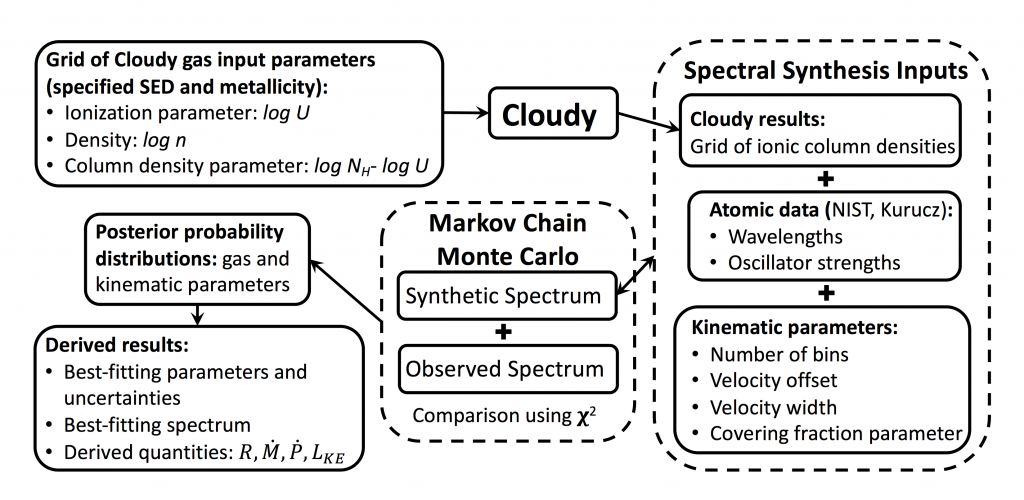Current Research
My current research involves development and implementation of SimBAL, a novel spectral synthesis method to analyze Broad Absorption Line Quasar (BALQ) spectra.
Within the last decade, large-scale cosmological simulations of formation of structure in the Universe have seen notable success. Key components of these models are stellar and AGN feedback. Feedback produces the observed scaling relations between black holes and their host galaxies, and is likely responsible for the bimodality of galaxy colors. A concern is that AGN and quasars cannot be resolved by the simulations, and feedback is included using tuneable parameters. Since many prescriptions work well, it is difficult to know what form feedback takes.
In the meantime, observers are looking for signatures of feedback, using the accepted criterion that 0.5-5% of the quasar bolometric luminosity needs to be available for feedback for the cosmological simulations to work. Broad absorption line quasars offer one of the most promising signatures of feedback. BALQs are relatively common, occurring in ~20% of quasars. The outflow velocities, readily measured in their rest-UV spectra, are found to extend to high velocities greater than 10% of the speed of light. The outflows are observed in multiple ionic species, and therefore the spectra have sufficient information to estimate the outflow properties relatively robustly.
However, the richness of the spectra hampers detailed analysis. The lines are often broad and blended. In addition, it has been known for nearly 25 years that the absorbers only partially cover the continuum emission region, so the lines can be saturated and not black. Direct measurement of individual lines is difficult or impossible in most objects, making quantifying the absorbing gas properties difficult or impossible.
With collaborators Don Terndrup (Ohio State University), Sarah Gallagher (The University of Western Ontario), and Gordon Richards (Drexel University), I have developed SimBAL, a spectral synthesis method for analyzing broad absorption line quasar spectra. SimBAL is a novel spectral-synthesis procedure that uses grids of ionic column densities generated by the photoionization code Cloudy and a Bayesian model calibration to forward-model BALQ spectra. A flowchart for SimBAL is seen below.

SimBAL offers nearly unlimited potential. We can measure directly the physical parameters of the outflowing gas, including ionization parameter, column density, and in many cases, gas density, often resolved as a function of velocity. Because SimBAL is a Bayesian method, it produces posterior probability distribution, and we extract best-fitting parameters and uncertainties on those values. We can also infer bulk outflow parameters, including the mass outflow rate, the distance of the outflow from the central engine, and the kinetic luminosity of the outflow. Thus, we can characterize the feedback potential of samples of objects. We can also learn about the physics of the outflows.
SimBAL is operational, but it is still being optimized, which means that there are plenty of opportunities to participate in this endeavor. SimBAL problems currently use advanced data analysis techniques including Markov Chain Monte Carlo (MCMC), principal components analysis (PCA), and cluster analysis. We are currently expanding to classification and other techniques. These tools have many potential applications beyond quasar physics.
SimBAL Publications
- H. Choi, K. M. Leighly, D. M. Terndrup, S. C. Gallagher, and D. T. Richards, “Discovery of a Remarkably Powerful Broad Absorption-line Quasar Outflow in SDSS J135246.37+423923.5”, (2020), ApJ, 891, 53
- K. M. Leighly, D. M. Terndrup, A. B. Lucy, H. Choi, S. C. Gallagher, G. T. Richards, M. Dietrich, and C. Raney “The z=0.54 LoBAL Quasar SDSS J085053.12+445122.5. II. The Nature of Partial Covering in the Broad-absorption-line Outflow” (2019), ApJ, 879, 27
- K. M. Leighly, D. M. Terndrup, S. C. Gallagher, G. T. Richards, & M. Dietrich, “The z = 0.54 LoBAL Quasar SDSS J085053.12+445122.5. I. Spectral Synthesis Analysis Reveals a Massive Outflow”, (2018) ApJ, 866, 7
